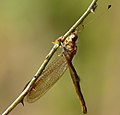English: Owlflies are dragonfly-like insects with large bulging eyes and long knobbed antennae. They are neuropterans in the family
Ascalaphidae; they are only distantly related to the true flies, and even more distant from the dragonflies and damselflies. They are diurnal or crepuscular predators of other flying insects, and are typically 5 cm (2.0 in) long.
The Ascalaphinae are the namesake subfamily of the owlfly family (Ascalaphidae), winged insects of the order Neuroptera. Most are found in the tropics. Their characteristic apomorphy is the ridge which divides each of their huge compound eyes; they are thus known as split-eyed owlflies.
According to D. E. Kimmins, "In the Asiatic species there may be specialized tufts of hairs on the prothorax, the prescutum and the supra-episternum, and in addition there may be a small triangular lobe on each side of the mesoscutum. The angle formed by the anal lobe of the fore wing has also been found of service in associating males and females. These specialized hairs on the thorax are also found in some of the African species of Helicomitus, and in other species, tufts of similar
hairs occur on the costal margin of the fore wing at the base, directed basally. The purpose of these curious
tufts of hair is not known, but it seems likely that they may have some connection with scent diffusion."
This is Ascalaphus sinister Walker, 1853, male (Identified by Joshua R Jones at Texas A&M University.) Helicomitus sinister (Walker, 1853) and Ogcogaster sinister (Walker, 1853) are synonyms.
Specification as in D. E. Kimmins' revision on 1949: "Male – Antenna slightly angled near base, but neither ciliate nor serrate. Posterior margin of pronotum simple, lateral angles with a tuft of short brown sets in addition to the normal long hairs. Prescuturn with lateral angles not specially swollen or elevated, outer third of posterior margin with a fringe of short brown setae. Mesoscutum without processes. Supra-episternum with a dense patch of short brown setae along its upper edge. Wings rather
narrow, apices acutely rounded, angle of anal lobe less obtuse than in H. dicax. Fourth tergite of abdomen very
slightly swollen, 4–5 with scattered, long, fine, black setae.
Female – Frons rather swollen, vertex elevated and with long hair. Anal lobe as in male. Abdominal tergites yellowish, narrowly bordered with fuscous, which is not
widened apically and basally."
Taken at
Kadavoor,
Kerala,
India.
Français : Les
ascalaphinae sont des insectes présentant une ressemblance avec les libellules, avec de grands yeux et de longues antennes terminées par une sorte de bouton. Néanmoins, ils n'ont qu'un très lointain rapport avec les libellules et les demoiselles.
Ce sont des insectes diurnes et crépusculaires, qui se nourrissent d'autres insectes volants. Il mesurent en moyenne cinq centimètres de long.















